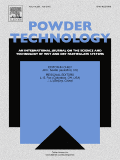
POWDER TECHNOLOGY
Scope & Guideline
Unleashing Potential in Powder Characterization
Introduction
Aims and Scopes
- Powder Processing Techniques:
Research on various methods for processing powders, including milling, granulation, and sintering, to optimize material properties and performance. - Characterization of Powders:
Studies that utilize advanced techniques to analyze the physical and chemical properties of powders, including particle size, morphology, and surface characteristics. - Applications of Powders:
Exploration of the use of powders in diverse fields such as pharmaceuticals, catalysis, energy storage, and environmental remediation. - Computational Modeling:
Development and application of models (e.g., DEM, CFD) to simulate powder behavior in processing and application scenarios, enhancing understanding and efficiency. - Sustainable Powder Technologies:
Research focused on eco-friendly and sustainable practices in powder production and application, including recycling and waste minimization. - Nanoparticles and Advanced Materials:
Studies on the synthesis, characterization, and application of nanoparticles and novel materials that leverage the unique properties of small-scale materials.
Trending and Emerging
- Sustainable and Green Technologies:
There is a growing focus on eco-friendly practices in powder processing, including the development of sustainable materials and methods that reduce environmental impact. - Advanced Characterization Techniques:
The application of cutting-edge characterization methods, such as high-resolution imaging and spectroscopy, is increasingly prevalent, allowing for deeper insights into powder properties. - Nanotechnology in Powder Applications:
Research into the synthesis and application of nanoparticles is on the rise, exploring their unique properties for applications in catalysis, energy storage, and environmental remediation. - Computational and Simulation Approaches:
An increasing number of studies are utilizing computational models to simulate powder behavior, enabling predictions and optimizations in processing and applications. - Biological and Medicinal Applications:
There is an emerging trend towards the use of powders in biomedical applications, including drug delivery systems and tissue engineering, showcasing the versatility of powder technology. - Hybrid Materials and Systems:
Research is trending towards the development of hybrid materials that combine multiple functionalities, enhancing the performance of traditional powder applications.
Declining or Waning
- Traditional Powder Metallurgy:
While still relevant, the emphasis on traditional powder metallurgy practices has lessened, with researchers increasingly exploring innovative and hybrid methods. - Single Material Systems:
There is a noticeable decline in studies focusing solely on single material systems, as more research shifts towards composite and multifunctional materials. - Conventional Flotation Techniques:
Research on conventional flotation methods has decreased, likely due to the rise of more advanced and efficient separation technologies. - Non-Eco-Friendly Practices:
As sustainability becomes more critical, studies involving non-eco-friendly powder processing methods are diminishing in frequency.
Similar Journals
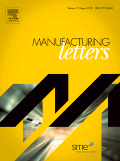
Manufacturing Letters
Advancing the Future of Manufacturing Innovation.Manufacturing Letters is a premier academic journal published by Elsevier, dedicated to advancing the fields of Industrial and Manufacturing Engineering and Mechanics of Materials. Established in 2013, this journal has quickly gained recognition, achieving a Q2 ranking in both disciplines as of 2023, highlighting its significance in the rapidly evolving manufacturing landscape. With an ISSN of 2213-8463, Manufacturing Letters provides a platform for researchers and industry professionals to share critical insights and innovative findings that drive the manufacturing sector forward. The journal is indexed in Scopus, where it ranks in the top 65th percentile for Industrial and Manufacturing Engineering and the 61st percentile for Mechanics of Materials, reflecting its impact in the scientific community. While primarily accessible through subscription, Manufacturing Letters aims to facilitate knowledge exchange, promote sustainable practices, and foster collaboration among individuals passionate about enhancing manufacturing efficiency and material development. This journal is indispensable for anyone looking to contribute to or understand the future of manufacturing.
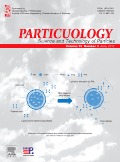
Particuology
Shaping Tomorrow's Innovations in Particle TechnologyParticuology is a premier international journal published by Elsevier Science Inc, focusing on the critical advancements in the fields of *Chemical Engineering*, *Condensed Matter Physics*, and *Materials Science*. As a Q2 journal in its respective categories for 2023, it offers a platform for researchers to disseminate their findings and engage with the latest developments in particle technology and related areas. With an impressive Scopus rank of 71/273 in General Chemical Engineering and 122/463 in General Materials Science, Particuology is positioned at the forefront of scientific inquiry and innovation. The journal encourages open access, ensuring that groundbreaking research is available to a global audience, thus fostering collaboration and knowledge sharing among academia and industry professionals. With a publication history dating back to 2008, Particuology continues to shape the future of particle science and engineering by providing rigorous peer-reviewed content that reflects the highest standards of academic excellence.
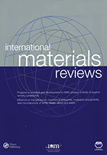
INTERNATIONAL MATERIALS REVIEWS
Unveiling Innovations in Metals and AlloysINTERNATIONAL MATERIALS REVIEWS, published by SAGE Publications Inc, is a leading journal dedicated to the comprehensive analysis of contemporary research in the fields of materials chemistry, mechanical engineering, mechanics of materials, and the study of metals and alloys. With an impressive impact factor and a Q1 ranking across multiple categories such as Materials Chemistry and Mechanical Engineering in 2023, it ranks amongst the top journals for innovative materials research. The journal has a long-standing history since its inception in 1987 and continues to serve as a crucial resource for academics and professionals alike. Although it is not open access, it is renowned for its rigorous peer-review process and its commitment to disseminating high-quality materials science research globally. Researchers, students, and industry professionals benefit greatly from the journal's insightful reviews, both for the advancement of theoretical knowledge and practical applications within the fast-evolving materials field.
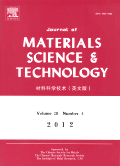
Journal of Materials Science & Technology
Unveiling Breakthroughs in Material DevelopmentThe Journal of Materials Science & Technology, published by JOURNAL MATER SCI TECHNOL in China, is a leading forum for the latest research in the multidisciplinary field of materials science. With the ISSN 1005-0302 and E-ISSN 1941-1162, this esteemed journal boasts an impressive impact factor and has established itself as a vital resource for professionals, researchers, and students alike. Covering a wide range of topics, including ceramics, composites, materials chemistry, mechanical engineering, and polymers, it has achieved a coveted Q1 ranking in multiple categories as of 2023, reflecting its position in the top tier of scholarly publications. Notably, the journal excels in its Scopus ranks, placing within the top 5% in categories such as Metals and Alloys and Mechanical Engineering. Aiming to foster knowledge and innovation in material development and application, the journal is committed to facilitating groundbreaking research and collaborations that propel the field forward. With its convergence of insights from 1993 to 2025, the Journal of Materials Science & Technology remains an indispensable resource for the advancement of materials science.
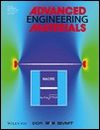
ADVANCED ENGINEERING MATERIALS
Elevating Research in Condensed Matter PhysicsADVANCED ENGINEERING MATERIALS is a leading journal dedicated to the field of materials science, particularly within the realm of condensed matter physics. Published by WILEY-V C H VERLAG GMBH in Germany, this esteemed journal has been a crucial platform for disseminating cutting-edge research since its inception in 1999. With an impressive impact factor and ranked in the top quartiles of its categories, it boasts a Q1 ranking in Condensed Matter Physics and a Q2 rank in related materials science fields as of 2023. ADVANCED ENGINEERING MATERIALS serves a diverse readership, including researchers, industry professionals, and students, striving to advance the understanding and application of innovative materials. Frequent contributions to this journal help bridge theoretical advancements with practical applications, fostering a vibrant academic and industrial dialogue. Although currently not an open-access journal, the insights shared within its pages are pivotal for anyone engaged in the dynamic sectors of engineering and material sciences.

INTERNATIONAL POLYMER PROCESSING
Exploring Innovations in Polymer Processing TechnologiesINTERNATIONAL POLYMER PROCESSING, published by WALTER DE GRUYTER GMBH, serves as a crucial platform for professionals and researchers in the fields of Chemical Engineering, Industrial and Manufacturing Engineering, and Materials Science, particularly focusing on polymers and plastics. With its ISSN 0930-777X and E-ISSN 2195-8602, this journal has been in circulation since 1988 and continues to expand its contributions to contemporary research trends through to 2024. Ranking in the third quartile across multiple categories, including Chemical Engineering (miscellaneous) and Materials Chemistry, it offers insightful and rigorous peer-reviewed articles that enhance the understanding of polymer processing technologies and innovations. This journal is vital for anyone engaged in polymer science and engineering, providing both theoretical and practical perspectives that advance the field. Although it does not provide open access, the journal's content is indispensable for academia and industry professionals looking to stay at the forefront of polymer research.

Materials Today Communications
Advancing Materials Knowledge for a Sustainable FutureMaterials Today Communications, published by ELSEVIER, stands as a prominent platform within the fields of Materials Chemistry, Materials Science, and Mechanics of Materials. With an open access format, this journal facilitates global dissemination of knowledge, aimed at enhancing collaboration and innovation among researchers, professionals, and students worldwide. Established in 2014 and converging through 2024, the journal has rapidly ascended through the ranks, achieving a commendable Q2 category status in multiple relevant categories. Specifically, its Scopus rankings highlight its influence, with rankings in the 64th to 69th percentile in various materials science domains. A key resource for those engaged in cutting-edge materials research, Materials Today Communications provides insightful coverage of contemporary advancements, bridging the gap between theoretical exploration and practical application.
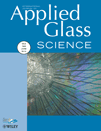
International Journal of Applied Glass Science
Pioneering Research in Glass Science and ApplicationsThe International Journal of Applied Glass Science, published by Wiley Periodicals, Inc, is a leading scholarly journal in the field of materials science, particularly focusing on the applications and innovations in glass science. Since its inception in 2010, the journal has served as a vital platform for disseminating high-quality research and advancing knowledge within the community, maintaining a respectable Q2 ranking in the Materials Science (Miscellaneous) category as of 2023. With an ISSN of 2041-1286 and E-ISSN of 2041-1294, it continues to attract a diverse array of manuscripts that explore fundamental and applied aspects of glass technology and its countless applications. Scholars and professionals benefit from the journal’s commitment to transparency and accessibility, even in the absence of an open access model, thereby reinforcing its relevance in an evolving academic landscape. The journal is positioned to be an influential resource for researchers, professionals, and students keen to stay at the forefront of glass science developments.
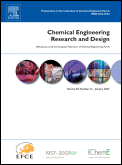
CHEMICAL ENGINEERING RESEARCH & DESIGN
Bridging Theory and Practice in Chemical Design.CHEMICAL ENGINEERING RESEARCH & DESIGN is a prestigious journal that has been at the forefront of dissemination in the fields of chemical engineering and general chemistry since its inception in 1983. Published by Elsevier, the journal features a rich array of research articles that contribute to both theoretical and practical advancements in the discipline. With an impact factor that positions it strongly within the Q2 quartile for both Chemical Engineering and Chemistry categories, it occupies an esteemed place in the academic community, being ranked #77 out of 273 in Chemical Engineering and #111 out of 408 in General Chemistry on Scopus. Researchers and professionals will find it an invaluable resource for cutting-edge research and innovative methodologies that shape the future of chemical engineering applications. While the journal does not currently offer open access, it remains accessible through institutional subscriptions, ensuring that important findings continue to reach a broad audience. With a scope that is poised to expand through 2024, the journal aims to foster collaboration and knowledge sharing, supporting the continuous evolution of the field.
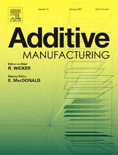
Additive Manufacturing
Pioneering Research in Additive Manufacturing ExcellenceAdditive Manufacturing is a leading international journal published by ELSEVIER, dedicated to the advancements and transformative applications of additive manufacturing technologies across various disciplines. Since its inception in 2014, it has emerged as a pivotal resource in the fields of Biomedical Engineering, Industrial and Manufacturing Engineering, and Materials Science, with an impressive impact factor and ranking in the Q1 quartile across multiple categories as of 2023. The journal serves as a platform for cutting-edge research, state-of-the-art techniques, and novel applications in additive manufacturing, making it essential reading for researchers, industry professionals, and students alike. By fostering a comprehensive understanding of the challenges and innovations within the field, Additive Manufacturing plays a crucial role in shaping the future of production technologies. With a strong readership and rigorous peer-review process, this journal ensures that its contributions remain at the forefront of manufacturing research and development.